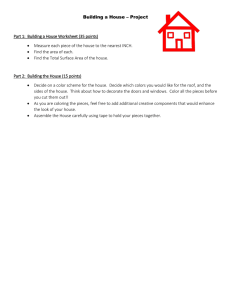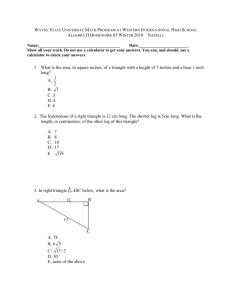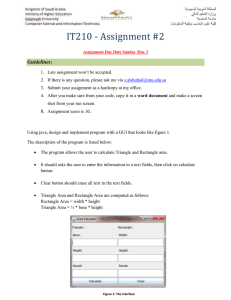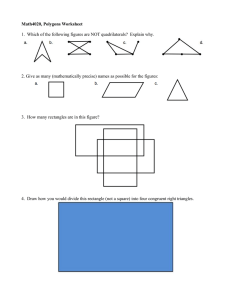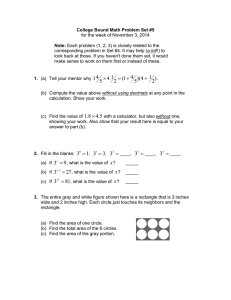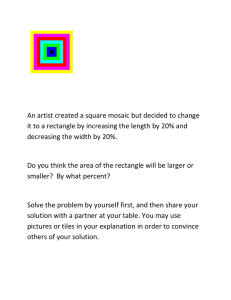What is Measurement? Exact Approximate
advertisement
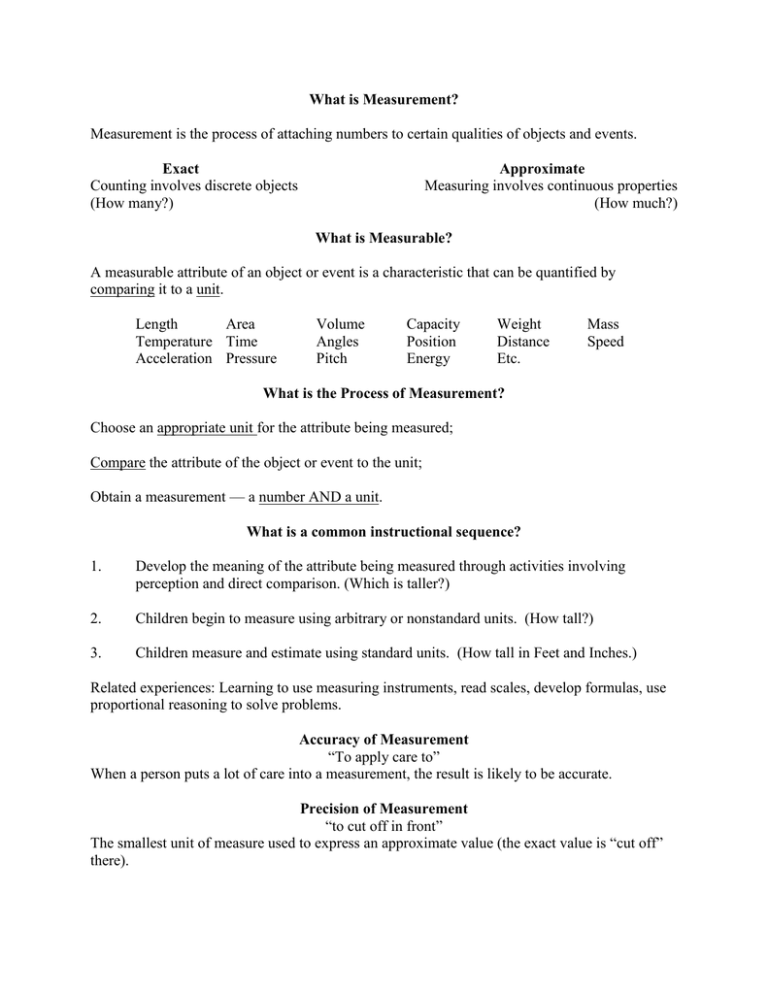
What is Measurement? Measurement is the process of attaching numbers to certain qualities of objects and events. Exact Counting involves discrete objects (How many?) Approximate Measuring involves continuous properties (How much?) What is Measurable? A measurable attribute of an object or event is a characteristic that can be quantified by comparing it to a unit. Length Area Temperature Time Acceleration Pressure Volume Angles Pitch Capacity Position Energy Weight Distance Etc. Mass Speed What is the Process of Measurement? Choose an appropriate unit for the attribute being measured; Compare the attribute of the object or event to the unit; Obtain a measurement — a number AND a unit. What is a common instructional sequence? 1. Develop the meaning of the attribute being measured through activities involving perception and direct comparison. (Which is taller?) 2. Children begin to measure using arbitrary or nonstandard units. (How tall?) 3. Children measure and estimate using standard units. (How tall in Feet and Inches.) Related experiences: Learning to use measuring instruments, read scales, develop formulas, use proportional reasoning to solve problems. Accuracy of Measurement “To apply care to” When a person puts a lot of care into a measurement, the result is likely to be accurate. Precision of Measurement “to cut off in front” The smallest unit of measure used to express an approximate value (the exact value is “cut off” there). Precision in Measurement An aspect of defining an “appropriate unit” in measurement. Introduction Recall that the process of direct measurement of a characteristic involves matching that characteristic of the object by repeating a unit, which is another object that has that same characteristic. So, when determining an appropriate unit for a measurement, one first has to find a good match between the characteristic of the object being measured and the unit used to do the measuring (It is hard to measure area with a measuring cup). Once the match is made, the next most important consideration may have to do with precision. Discussion question Suppose a length is reported as 2 ¾ inches, to the nearest ¼ inch. How long and how short could it actually be? Commentary on Precision, from Reconceptualizing Mathematics, Center for Research in Mathematics and Science Education, San Diego State University. Unfortunately, much school work with measurement treats the values as exact, so one can easily form the erroneous impression that the values are exact. Like the ideal constructs of “line segment” and “angle,” theoretically perfect measurements can be discussed, of course. We can imagine a square with sides exactly 2 centimeters long, for example, even though drawing one with even a finely sharpened pencil is not possible. We can imagine a line segment with length exactly 2 cm although we cannot literally produce one. Which of these two ways would give a better measurement for the length of a board: measuring to the nearest inch, or measuring to the nearest foot? In a direct measurement, choosing the smaller unit naturally allows the matching to be done more closely. So usually a measurement with a smaller unit narrows the range of possible values for the measurement and lessens the error. The numerical part of the value, however, can also imply something about the accuracy of the measurement. Suppose you have these measurements, all reported for the length of the same object: 2.75 feet; 2 feet 9 inches; and 33.0 inches. Which one is most accurate, or are they the same? A measurement given as 2.75 feet, say, is implying that the measurement was carried out to the nearest onehundredth of a foot, so it would be more accurate than a measurement reported as 2 feet, 9 inches, which implies that the measurement was carried out only to the nearest inch, or one-twelfth of a foot. On the other hand, 33.0 inches would imply a measurement to the nearest one-tenth of an inch, or 1/120 of a foot, so 33.0 inches would be the best approximation of the three given here—2.75 feet, 2 feet 9 inches, and 33.0 inches. Summary 1. Different units produce different numerical measures of the same attribute of an object. 2. Smaller units of measure provide a more precise measure. Related CA Standards Kindergarten 1.1 Compare the length, weight and capacity of objects by making direct comparisons or using reference objects (e.g., shorter/longer/taller, lighter/heavier, which holds more?) 1st Grade 1.1 compare the length, weight and volume of two or more objects using direct comparison or a non-standard unit nd 2 Grade 1.1 measure the length of objects by iterating (repeating) a non-standard or standard unit 1.2 use different units to measure the same object and predict whether the measure will be greater or smaller when a different unit is used 1.3 measure the length of an object to the nearest inch and/or centimeter 3rd Grade 1.1 choose appropriate units (metric and U.S. customary) and tools, and estimate and measure length, liquid volume and weight/mass 4th Grade 1.1 measure the area of rectangular shapes, using appropriate units 5th Grade 1.4 differentiate between and use appropriate units of measures for, two- and three-dimensional objects (perimeter, area and volume) Notes Area by Comparison Related CA Standards Note that the CA Standards contain very specific language about measuring area with respect to squares and rectangles. Why is this so? 3rd Grade 1.2 estimate or determine the area and volume of solid figures by covering them with squares or by counting the number of cubes that would fill them 4th Grade 1.1 measure the area of rectangular shapes, using appropriate units 5th Grade 1.1 derive and use the formula for the area of right triangles and of parallelograms by comparing with the area of rectangles (i.e., two of the same triangles make a rectangle with twice the area; a parallelogram is compared to a rectangle with the same area found by cutting and pasting a right triangle Historical Note: Edward G. Begle1 During the late 1950s, in the midst of the Cold War, there was a perception that the United States had fallen behind the Soviet Union in basic research and education in mathematics and the sciences. In 1958 the National Science Foundation (NSF) provided $100,000 to initiate a revision of the secondary mathematics curriculum. The project was called the School Mathematics Study Group, or SMSG, and Edward G. Begle of Yale University was given the responsibility for directing its efforts. SMSG developed sample textbooks for grades K-12 that were field tested during the early 1960s across the nation. While many of the revisions that were suggested became the target of criticism (see, for example, Morris Kline, Why Johnny Can’t Add, New York: Vintage Books, 1973), the SMSG postulate set for geometry received positive reviews and became, in various forms, widely used throughout the United States and Canada. The SMSG postulates include a few that directly address the concept of Area: Postulate 17. To every polygonal region there corresponds a unique positive number (called the area of the polygonal region). Postulate 18. If two triangles are congruent, then the triangular regions have the same area. Postulate 19. Suppose that the region R is the union of two regions R1 and R2. Suppose also that R1 and R2 intersect at most in a finite number of segments and points. Then the area of R is the sum of the areas R1 and R2. Postulate 20. The area of a rectangle is equal to the product of the length of its base and the length of its altitude. 1 Wallace, E. C., S. F. West. Roads to Geometry, 2nd ed. Upper Saddle River, NJ: Prentice-Hall, 1998: 58. The postulates on the previous page essentially indicate that all area formulas for shapes in the plane can be derived from the definition of the area of a rectangle as given in postulate 20 (in mathematics we start with a set of ideas and build from there). IN FACT, in Calculus we even calculate areas of regions in the plane with wildly curved boundaries using by adding up the areas of lots of little rectangles that approximately cover the region. The activity below illustrates how one uses the rather simple idea of comparison to make connections between rectangular areas and areas of other polygons. Activity 1: Rectangles To Circles GOAL: Use paper folding and transformations to derive the areas of basic shapes by relating them to the area of a rectangle. Triangle Mark a point on the top of the rectangle and connect the two base vertices to the point. This gives you a triangle. Cut off the excess area outside the triangle. What is the base and height of the triangle in relation to the original rectangle? Fit the excess area that was cut off onto the triangle. What does this tell you about the area of the triangle? Write the formula for the area of a triangle. Parallelogram Mark a point on the top of the rectangle and connect one of the base vertices to the point. Cut along this line and translate the cut triangle to the opposite side of the rectangle, and tape to form a parallelogram. What is the base and height of the parallelogram in relation to the original rectangle? What does this tell you about the area of the parallelogram? Write the formula for the area of a parallelogram. Trapezoid Fold the rectangle in half lengthwise, crease and unfold. Mark two points anywhere on the top of the rectangle and connect each one to the closest endpoint of the creased line. Cut off the two small triangles formed in the top corners. Rotate them 180° about the endpoints and tape to get a trapezoid. What dimensions of the trapezoid relate to the original rectangle? What does this tell you about the area of the trapezoid? Write the formula for the area of a trapezoid. Circle Cut out a large circle. Fold it in half and crease. Continue to fold and crease until you have 16 sectors. Cut the circle into 16 sectors. Rearrange the sectors, fitting the straight sides together, placing the curved sides alternating up and down. What shape does this approximate? Cut the sectors into narrower sectors and arrange as before. What shape will be approached? What is the base and height of this shape in relation to the original circle? What does this tell you about the area of the circle? Write the formula for the area of a circle.
